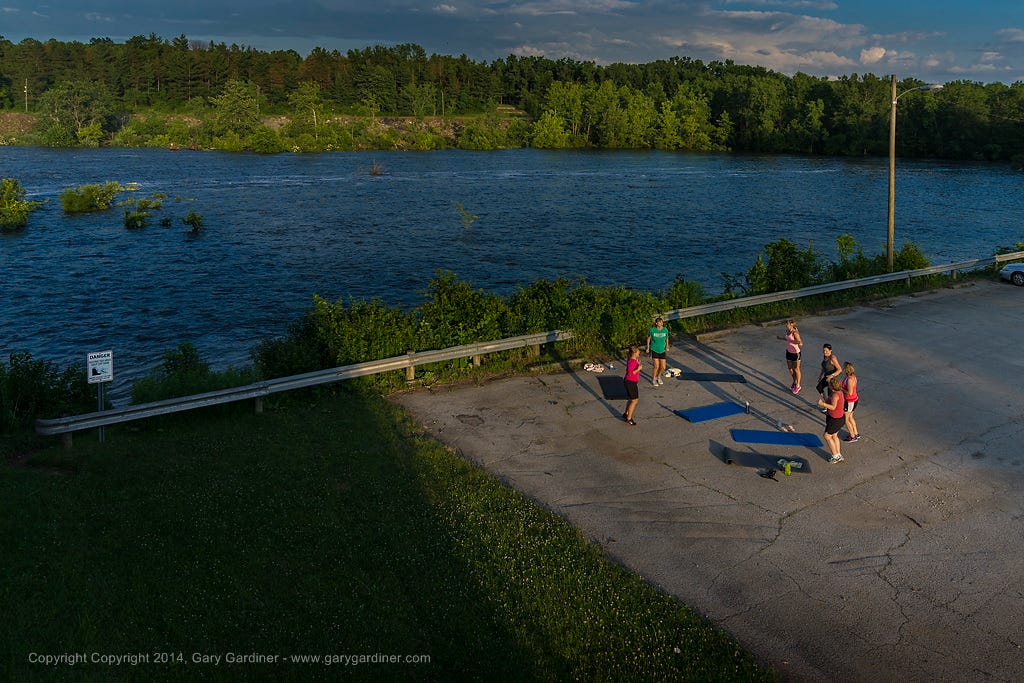How to Build Your Personal Style in Photography: Start with the Basics
If you’re new to photography or have been doing it for a while but want to take your images to the next level, this one’s for you.
One of the most common questions beginner photographers ask is, ‘How do I find my style?‘
The truth is, style isn’t something you apply like a filter. It’s not a preset, a trend, or something you download. Your style is the sum of your choices: what you shoot, how you frame it, when you click the shutter, and how you process the final image. However, to develop that style, you must first understand and master the basics—composition, lighting, timing, contrast, and the concept of peak action.
Let’s walk through those using a simple, real-world example: a photo of a small group workout taking place in a quiet parking lot next to a river. Nothing dramatic. No models, no special effects—just people moving through a moment.
But it tells a story. And that’s where the magic begins.
1. Composition: Where the Story Lives
Great photos aren’t accidental. Even spontaneous moments benefit from thoughtful framing. In this workout photo, the elevated angle divides the image into two natural layers: the busy foreground with people in motion, and the calm, tree-lined river in the background.
This composition adds meaning. It shows contrast between motion and stillness, effort and nature, routine and beauty. The viewer’s eye naturally moves through the frame because it’s structured to guide us.
Try this: The next time you’re shooting, pause and take a look at your scene. Move your feet. Change your angle. Ask yourself, “What’s the most important part of this story, and how can I show it clearly?”
2. Lighting: Your Mood Setter
Lighting is one of the easiest ways to elevate your photos—and one of the most overlooked. In the photo above, the warm golden-hour light does more than make things look pretty. It gives the image depth, emotion, and texture. Long shadows stretch across the pavement. The colors glow. Even the cracks in the ground tell a story.
Golden hour (just after sunrise or before sunset) is beneficial for beginners. The light is soft, directional, and forgiving.
Pay attention to:
Where the light is coming from
How does it change the colors in your scene
What kind of shadows does it create
Learning to see light is a game-changer.
3. Timing: Wait for It
Photography is often described as the art of capturing a moment. But great photographers don’t just capture moments—they anticipate them.
In this scene, the timing feels natural. The participants are mid-motion. One person is speaking, others are stretching or waiting. It’s a slice of life, but it feels alive because the photographer caught the rhythm of the group.
This is what we refer to as “peak action.” It’s not just about catching the fastest or most dramatic moment. It’s about finding the instant that best tells the story.
Tip: Don’t just react to what’s happening; instead, take a moment to consider your response. Learn to watch. Wait for the right gestures, expressions, or movements. Let the moment build—and then take the shot.
4. Contrast & Color: Show What Matters
Contrast can mean many things. In this photo, there’s both visual contrast (light and shadow) and color contrast (cool blues vs. warm tones). This helps important elements stand out without being forced.
Great photographers use contrast to direct the viewer’s gaze where they want it to go. It’s a way of saying, “Look here.”
What to look for:
Light/dark balance
Color relationships (warm vs. cool, bright vs. muted)
Texture—does the surface add visual interest?
Small choices in color and contrast shape the viewer’s emotional response to your image.
5. Style: The Result of Seeing with Intention
This is where it all comes together. Style isn’t just about editing or what gear you use. It’s about what you notice and choose to include.
In the case of the creekside workout photo, I didn’t just see a parking lot; they saw an opportunity. There was potential waiting for the light to be right, noticing the setting sun casting long shadows, anticipating the class’s rhythm, and capturing the moment when all those elements aligned.
That’s style. It’s not added later. It’s baked into the shot.
Final Thought: Watch Before You Shoot
If there’s one habit that will instantly improve your photography, it’s this: slow down and watch.
Before you lift your camera, take a moment to:
Read the light
Observe the movement
Listen to the energy of the scene
Look for patterns, shapes, and storylines
When you learn to recognize the moment where everything lines up, composition, light, timing, and emotion, you’ll start making photos that feel like your own. That’s when your personal style begins to emerge, not as something you imitate, but as something you discover.
You don’t need the perfect subject, just patience, awareness, and curiosity. Even a parking lot at sunset can become a place where stories are told. If you know how to see them.
My Final Photo News is a reader-supported publication. To receive new posts and support my photography and commentary, become a free or paid subscriber. Subscribe to The Westerville News and PhotoCamp Daily. My Final Photo News also recommends Civic Capacity and Into the Morning by Krista Steele.


